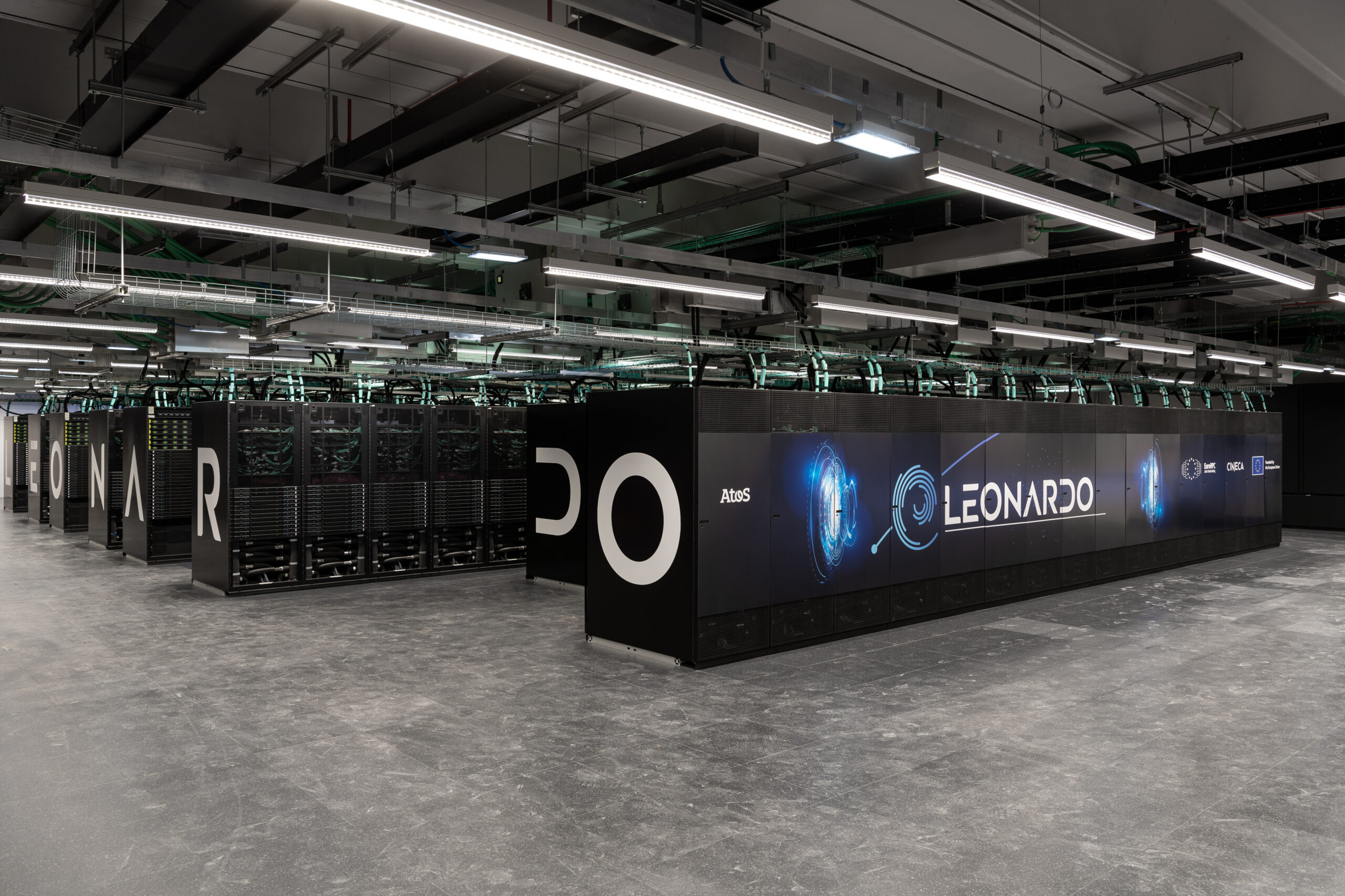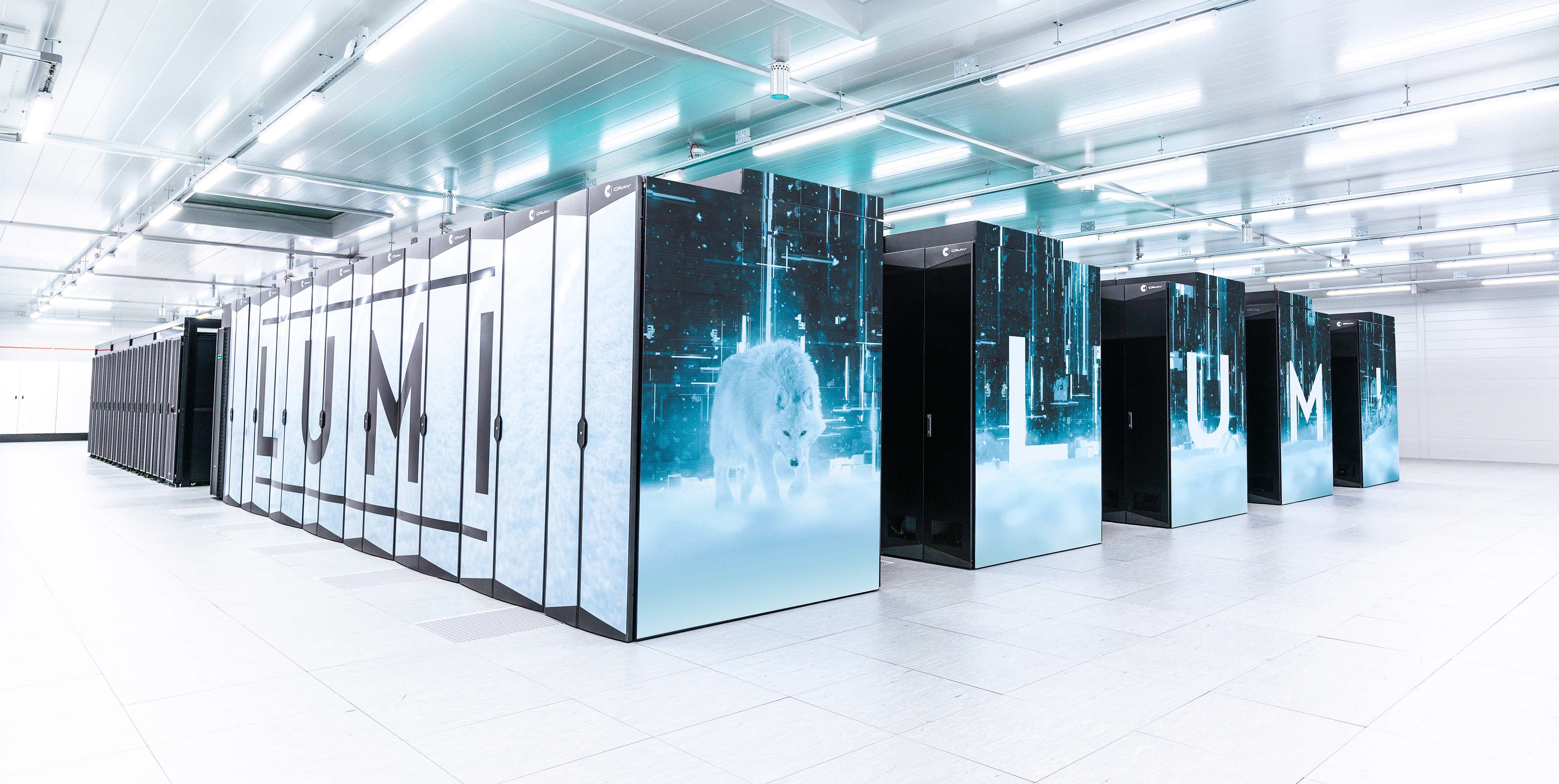Image: LUMI data center in Kajaani, Finland. CSC
Several acceptance letters for large HPC grants have recently landed in associate professor at the Department of Mathematics and Computer Science, Antonio Rago’s, email inbox. Antonio Rago is part of several international research groups, whose innovative research seeks to uncover some of the big unanswered questions within the field of particle physics. In the last two years, they have secured a hugely impressive 483.000.000 CPU core hours and 1.634.000 GPU node hours.
A tiny signal that explains a big problem

It is less than a year ago that we published an article about Antonio Rago’s massive EuroHPC grant of 120.000.000 CPU core hours on the LUMI supercomputer. The grant is the largest that has ever been given for HPC not only to an SDU researcher, but to any researcher in Denmark.
Already in November last year, the same group received some good news again: this time, the allocation was 130.000.000 CPU core hours on LUMI and, on top of this, 500.000 GPU node hours on another EuroHPC JU supercomputer, Leonardo. Though Rago is not the PI of this project, he will still play a large role in the experiments that his group will conduct with this massive computing power.
As with the previous grant, Rago and his group are seeking to uncover the mechanisms behind the unbalance in the universe between matter and anti-matter. Since the Big Bang, there has been a competition between matter and anti-matter. They were once equal in size, but some mechanism, which is still unknown to scientists, has resulted in an overwhelming victory of matter over anti-matter, leading to the universe that we know today, which contains comparatively little anti-matter.
The task that Rago and his group have set themselves is daunting: gigantic simulations on large and complex supercomputers is required, and the precision must be extreme. The discrepancies between the predictions of the Standard Model of particle physics – a model which encapsulates the theories and discoveries of thousands of physicists since the 1930s[1] – and the experiments made in simulations by researchers are extremely small.
“The Standard Model seems to be unbelievably good at describing the particles, and whatever we have made so far in the experiment matches, after a lot of calculation, what is predicted by the Standard Model. In the Standard Model, however, we have some corners that are working, but we don’t understand why. In this indetermination could be hidden stuff that is unknown. We need a tiny signal that explains a big problem,” says Antonio Rago.

Leonardo, hosted by CINECA, Italy 
LUMI supercomputer, hosted by CSC, Finland
With the new grant, the researchers took a complementary approach to the previous one. Now the group will test whether the unbalance can be explained by looking at one of the contributions to the neutron electric dipole moment, the so-called theta term. The theta term, according to the Standard Model, should have the value 0.
“Usually, when something is exactly zero, there is a reason. But we do not have a good explanation for why the theta term should be zero. We have a good explanation for why it should be small. Small we know and understand. But not zero, exactly zero. It’s a bit problematic for us,” says Antonio Rago.
If the value of the theta term is 0, the Standard Model alone does not explain why we see matter all around us.
“So, there are two options,” Antonio Rago explains. “One is, within the Standard Model, the theta term that practically we have switched off needs to be switched on. Or there is something more – something Beyond the Standard Model. Either way, studying the theta term needs to be done.”
A new frontier
For the more recent EuroHPC allocation, Rago and his group chose to apply both for CPU and GPU resources. It is relatively recently that GPUs (graphics processing unit) became available as an HPC resource – their emergence primarily driven by AI – meaning that many researchers are still adapting their algorithms to make full use of these powerful machines. If used correctly, GPUs can offer more computational power than CPUs. Because they are more efficient, they are also more environmentally friendly.
“We can certainly say that GPUs have opened a new frontier for us because they allow for higher computational density. But there is still room for improvement, indeed one thing is the theoretical performance of the GPU versus the theoretical performance of the CPU. Another thing is the actual performance of our code, written specifically for CPU, then ported to a GPU. I will not claim that we have the same increase in performance as the theoretical performance of the machine. But we certainly have a very impressive increase in performance,” says Antonio Rago.
The Leonardo GPUs are NVIDIA based, and because Leonardo was not ready for users at the time when Rago and his group applied for resources, they tested their code on the A100 NVIDIA GPUs available at SDU via the DeiC Interactive HPC service.
Rago and his groups’ successful EuroHPC application is a testament to the fact that easy access to national resources can help Danish researchers to secure the competitive, European grants.
“Investing in and testing GPUs, as we are doing here at SDU at the moment, is crucial. For us, the foreseeable future is the GPU,” says Antonio Rago.
Quantum revolution
According to Antonio Rago, the GPU is also important for the development of quantum computers.
“Any quantum computer, no matter what, is going to need in its infancy and in its production to be coupled to a classical computer. Additionally, the development of quantum algorithms will not be done on quantum computers – this would be way too expensive and cumbersome, given the current efficiency of quantum computers. We’re going to develop quantum algorithms on simulators and these simulators are efficient and properly represented on GPUs,” says Antonio Rago.
Antonio Rago is part of the Quantum Field Theory Center at SDU where they study the theories underneath the quantum world; theories which can be dated back to the beginning of the 20th century and to researchers like Albert Einstein and Niels Bohr. Quantum computers are built on the foundations of quantum mechanics – a field which again builds on the principles of quantum field theory.
Rago is also taking part in the Q-Access working group in DeiC whose tasks is to secure access to test- and production quantum platforms for the Danish community.
As of yet, classical simulations of quantum field theory is much more advanced than today’s quantum computers. Despite the potential they may one day bring to his research, Rago does not foresee using them anytime soon:
“I cannot list a single problem for which a quantum computer in its present state will be better than my laptop. We have already identified incredible hard problems and how to solve them on the quantum hardware once available and usually such problems require exponentially large traditional computation power to be otherwise solved. From this it is clear that a quantum computer is going to knock down a traditional computer one day.”
Antonio Rago and his collaborators have secured the following grants in 2023-24:
| Dirac 15th Call UK (April 2023) Phenomenology of Composite Higgs models at the LHC Dial-3: 40.600.000 cpu core hour PI: Dr Drach Co-I: Prof Rago | GCS proposal for tier 0/1 HPC access (April 2024) Hadron structure with stabilized Wilson fermions Juwels Booster: 133.906,5 gpu hours Juwels CPU: 49.700.000 cpu hours PI: Dr Shindler Co-I: Prof Francis, Prof Rago, Dr Zafeiropoulos |
| EuroHPC Extreme Scale Access (May2023) Master field – infinite volume lattice QCD LUMI-C: 120.000.000 cpu core hours PI: Prof. Rago Co-Pi: Dr. Bulava, Dr. Cé, Prof. Francis, Prof. Fritzsch, Dr. Green, Dr. Hansen. | GCS proposal for tier 0/1 HPC access (April 2024) QCD simulations with stabilised Wilson fermions, towards the physical pion mass at a fine lattice spacing Hawk: 99.000.000 cpu core hours PI: Dr Jangho Kim Co-I: Mr Basta, Prof Francis, Prof Fritzsch, Prof Rago, Dr Walker-Loud, Dr Zafeiropoulos |
| EuroHPC Extreme Scale Access (November 2023) The theta term contribution to the neutron electric dipole moment with stabilized Wilson fermions LUMI-C: 128.699.904 cpu core hours Leonardo: 462.725 gpu node hours PI: Dr Shindler Co-I: Prof Francis, Prof Fritzsch, Prof Rago, Dr Walker-Loud, Dr Zafeiropoulos | Dirac 16th Call UK (April 2024) Phenomenology of Composite Higgs models at the LHC (Continuation project) Dial-3 + Dial-2: 43.000.000 cpu core hour PI: Dr Drach Co-I: Prof Rago |
| DeiC – H1-2024 (December 2023) B-meson mixing and lifetimes: a search for new physics. LUMI-G: 1.043.515 GPU hours PI: Prof Rago Co-I: Prof Harlander, Dr Black, Prof Witzel Dr Lange Dr Shindler |
More Information:
EuroHPC JU calls, including the Extreme Scale Access Mode calls which Antonio Rago and his group applied for, are open on a continuous basis and you can apply for resources on all the eight EuroHPC machines. Find out more here.
National HPC resources are available to all Danish researchers. The SDU eScience Center is hosting two of the services, one of them in collaboration with Aalborg University and Aarhus University, where you can also apply for GPU resources. Find out more here.
If you are employed at SDU and you would like to test the SDU eScience Center’s services or know more about how we can help you in your research, please contact support@escience.sdu.dk. The SDU eScience Center can also help you in your journey to transition your code to GPUs and with an application for a EuroHPC or national HPC grant.
Two advanced quantum computing apps were recently added to the UCloud platform by the developers here at the SDU eScience Center – apps which can be used on NVIDIA H100 GPUs, the latest generation and most powerful NVIDIA GPU.
At the DeiC conference last year, Antonio Rago gave a presentation about how HPC resources accelerates his research. You can find the recording of the presentation here.
[1] https://home.cern/science/physics/standard-model


